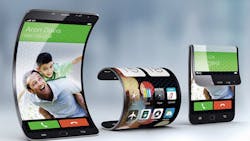1. Electrovibration Technology: The Touch and Feel of It
Electrovibration technology will change the mobile touchscreen experience dramatically. You will be able to feel different kinds of texture. I know what you are thinking. The online shopping experience will go notches higher. Imagine shopping for clothes online without worrying about the texture and quality of the cloth.
Disney researchers have been working intensively on developing touchscreens that let you feel texture. While electrovibration technology should have become a reality by now, there have been some delays in the process. However, tech experts say that 2017 will herald the arrival of electrovibration technology on a large scale across touchscreen devices. It works on the phenomenon that, through electrostatic charges, your brain is tricked into feeling texture simply by touching the device’s screen. Apple has also been working in electrovibration technology and has filed several patents related to the technology.
This advancement can also lead to socially beneficial trends. For instance, blind people can use it for Braille, and access smartphones like everybody else.
2. Speech-to-Speech Translation: Communicating with the World Through a Fingertip
In 2012, Microsoft demonstrated impressive speech-to-speech translation and now, real-time multi-language conference calls may finally become a commercial reality in 2017. IBM has also mentioned that it will open its Watson supercomputing platform to third-party developers. This will allow natural language processing features to be built into apps. Imagine discussing important matters across the globe with just a tap, in multiple languages without the aid of a translator or a mediator.
3. The Brain-Computer Interface: When Your Thoughts Become Commands
Every thought that occurs in our brain has its own brainwave pattern. Hence, no two electrical signals are the same. These unique electrical signals can be mapped out to carry out specific commands. So basically your smartphone with its brain-computer interface can detect the brainwaves emitted with your thoughts and execute the set command.
This is a futuristic technology that could see some commercial application in smartphones in 2017. Think if your phone could simply detect that you need the curtains drawn, and you are too sleepy to get out of bed. And before you know it, it is done. The potential for such an amazing user interface that allows you to control your smartphone with your mind is limitless.
4. Wireless, Speedy Charging Becomes a Reality
Running out of battery power is one of the most persistent and frequent complaints of most smartphone users. We use our smartphones for multiple purposes simultaneously. The result is a drained battery. Most users reveal that they need to charge their device every day. However, there has been a buzz in the tech world for some time now that smartphone users will be able to charge their cellphones through day-to-day motions like walking or tapping the screen. Your body heat could also aid in charging your phone.
Another revolution we are keenly awaiting is the availability of the ultra-rapid charger that comes with an advanced battery technology that will allow you to charge your phone completely in just 30 seconds. Besides these, another futuristic trend that will hopefully go mainstream in 2017 is where one gadget can be used to charge another without connecting them through any wires.
5. Flexible and Wearable Smartphones
Today represents a new era in which flexibility and wearability are becoming keywords in the dynamics of mobile phones. Screens will soon be able to be folded and unfolded, owing to Organic Light Emitting Diode (OLED) technology. So you can watch your favorite movie and game on a large screen and the fold it to pocket size and put it away without any hassle. This technology will also enable the prevalence of paper-thin screens that can project from both sides of the screen. What this translates for users is the ability to show pictures or videos to your friend on one side, while using the other side as a control to maneuver videos and images as you like.
With the introduction of physical flexibility in smartphones, companies are also working toward manufacturing wearable smartphones. Use it as a handset as and when you like and then it turns into a wristwatch you can sport. While this will not be a pioneering concept in mobile technology, it is something that should be made available to the masses by 2017.
6. Augmented Reality
The future of mobile technology closely revolves around two words: “augmented reality” (AR). AR in simple terms means an advanced and unseen version of what we can see with our naked eyes. A regular sight when perceived through our smartphone infused with the AR technology will be enhanced through the use of computer-generated sensory input such as sound, video, graphics and GPS data.
A surgeon performing a complicated procedure or a firefighter trying to find his way out of a burning building can visualize a much more accurate and safe course of action with the help of augmented reality. Similarly, you can see a particular place through your augmented reality incorporated smartphone camera, and immediately find out the nearest cafes, bookshops, dining places.
Will the next mobile technology revolution kick in this year? Will the above technological trends permeate to the average smartphone user? Only time will tell.
Ann Neal (twitter: @Ann_G_Neal) is a freelance writer who covers technology and business. She is writing on behalf of independent electronic components distributor, Dig Semi.







